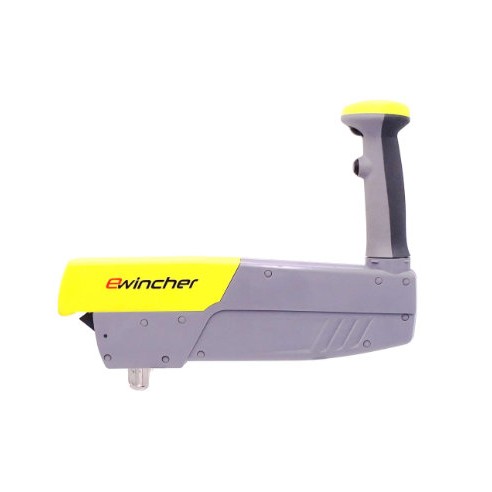Operate your winches without more effort!
Ewincher 2
Handle Ewincher with battery, charger, converter, pocket and its container.
Correlated accessories
Prodotti alternativi
Product Details
- Height (mm)
- 288
- Width (mm.)
- 355
- Depth (mm)
- 66
- Weight
- 2.2 Kg
- Batteries
- Li-Ion 25.2V
- Rotation speed
- 15 to 80 rpm
- Torque (Nm)
- Up to 80
Description
3 MODES OF USE
ELECTRICAL MODE: for maximum help, the motor Ewincher does all the work.
MANUAL MODE: for making an adjustment, as with a classic crank handle.
COMBINED MODE: for exceptional recovery speed.
ELECTRIC MODE:
Press the trigger on the handle, hold the handle still and winch effortlessly!
Two non-exclusive, cumulative functions allow you to optimize mode speed control.
Variable hoist speed. Simply with the tip of a finger, with light pressure on the handle trigger, you control the rotation speed of Ewincher, which can be up to one hundred revolutions per minute! The more you press, the faster the crank goes!
Recall that most winches have two speeds: a low speed when turning in one direction and a high speed when turning in the opposite direction. Ewincher adapts perfectly to this peculiarity of winches and allows you to choose between two speeds, high and low, regardless of the line tucking speed that you can always control.With Ewincher you can constantly control the rotation speed and choose at any time to use the high or low speed of the winch.
Switching between winch speeds can be done in two ways:
By simply pressing the second button on the handle, located directly below the knob.
In a much more intuitive way, tilting the handle of theEwincher on the other side of the winch switches to the direction of winch speed in which you wish to operate. From the very first use you will adopt this completely intuitive feature.
MANUAL MODE:
Ewincher could be confused, in shape and size, with a classic crank handle, precisely because it can be used as such.Don't lose the pleasure of tucking and the joys of sailing: to use Ewincher in manual mode, hold down the second button, located below the knob, and cock as usual.This feature is especially useful when you want to fine-tune a setting manually or simply feel and check the tension of the lines: no need to change the crank handle, you already have a classic crank handle in your hands!COMBINED MODE:
The combined mode is to use the electric mode and, instead of holding the crank steady, to use the manual winch at the same time: you then add the two speeds of rotation and thus achieve an unparalleled travel speed.This mode is very useful at the beginning of a maneuver, when you have very little tension on the lines and need to tuck in very quickly.
USE SUITABLE FOR ALL PHASES OF NAVIGATION
With its three operating modes, Ewincher makes your navigation comfortable and adapts to any kind of maritime situation: its flexibility of use and its incredible functionality allow everyone to use it at any time of the maneuver.Each phase of a maneuver requires different needs: the operating modes of Ewincher fully respond to them by adapting perfectly to the reflexes, intuitions and habits of sailors.
1) Tension the line and prepare the maneuver
At the beginning of every maneuver, whether hoisting the mainsail or caulking the genoa, the lines are slack: at this point, caulking requires little effort. Regardless of whether they are caulking by hand or with a full-speed winch, sailors expect this stage to be particularly fast: Ewincher now allows you, by opting for combined mode, to caulk the lines in record time (up to 160 rpm)!
2) Cazzing at full speed
When the line starts to tighten, sailors usually caulk at high winch speed (i.e., counterclockwise): with Ewincher, you can then switch to electric mode, operating it at high winch speed.
3) Adapt to the tension
At the end of the maneuver, when the line tension is at its maximum, caulking by hand, at high winch speed becomes increasingly difficult. Crew members at that time generally change the direction of rotation and caulk at low winch speed. Voltage also acts on Ewincher: so reverse the direction of rotation to take advantage, still in electric mode, of low winch speed.
4) Refine the final settings
To make final adjustments, or refine them later while sailing, you can continue to use the electric mode of Ewincher, adjusting and controlling the gear speed, or use the manual mode directly.










